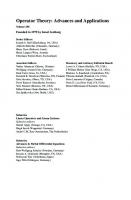Operator Theory, Analytic Functions, Matrices, and Electrical Engineering 0821807188, 9780821807187
This book expands the lectures given at a regional conference in Lincoln, Nebraska which brought together a wide variety
300 96 39MB
English Pages 134 [75] Year 1987
Recommend Papers

- Author / Uploaded
- J. William Helton
- Joseph A. Ball
- John N. Palmer
- Charles R. Johnson
File loading please wait...
Citation preview
UNIVERSIDADE·DE·SÃO;PAULO 0 ·
Q
ESCOLA .PúLITECNICA o
117f57
N. ······················· ·
.
OPERATOR THEORY, ANAL YTIC FUNCTIONS MATRICES, ANO ELECTRICAl ENGINEERING
Expository Lectures from the CBMS Regional Conference held at Lincoln, Nebraska August 1985 Research supported in part by National Science Foundation Grant DMS-8301394 and Office of Naval Research N000 14-85-K-0070. 1980 Mathematics Subject Classifications ( 1985 Revisioní; Primary 4 7-0 l, 46-0 l, 93-XX, 22-XX, 30-XX, 42-XX, 49-XX.
Library of Congress Cataloging-in-Publication Data Helton, J. William, 1944Operator theory, analytic functions, matrices, and electrical engineering. (Regional conference series in mathematics, ISSN O l 60- 7642; no. 68) Bibliography: p. l. Functional analysis. 2. Operator theory. 3. Matrices. I. Conference Board of the Mathematical Sciences. II. Title. III. Series. 87-1192 510 s [515.7] QA1.R33 no. 68 [QA321] ISBN 0-8218-0718-8
Contents
vii
Preface Part I. Englneering motlvatlon L Engíneerlng background
3
What is the transfer function-how analytic functions arise in engineering-connection laws. 2. Engíneeríng problema
11
Engineering problems ( vs. analysis); a control paradigm. Part H. Analytlc functlon theory Copying and reprinting. Individual rcadcrs of this publication, and nonprotit librarics acting for thern. are pcrrniucd to makc Iair use of thc material, such as to copy an articlc for use in tcaching or rcscarch. Permission is granied to quotc bricf passagcs from this publication in reviews, provided the customary acknowlcdgment of the source is given. Republication. systernatic copying, or multiple reproduction of any material in this publication (including abstracts) is permitted only under license from the American Mathematical Society. Requests for such permission should be addressed to the Executive Director , American Mathematical Society, P.O. Box 6248, Providcnce, Rhode lsland 02940-6248. The owner consents to copying beyond that permitted by Sections 107 or 108 of the U.S. Copyright Law, provided that a fee of $1.00 plus $.25 per page for each copy be paid directly to the Copyright Clearance Ceruer, lnc .. 27 Congress Strcet. Salem. Massachusetts O 1970. When paying this fee please use the code 0160-7642/90 to refer to this publication This consent does no! exicnd to other kinds of copyi ng, such as copyi ng for general d istri but ion. for ad vert isi ng or prornot ional pu rposes, for crea li ng new collective works. or for resale.
Copyright© 1987 by the Arncrican Mathernatical Society. Ali rights reserved. Printed in the United States of Arnerica Thc American Mathernatical Society retains ali rights except those granted to the United States Governrnent. The paper used in this book is acid-free and falis within the guidelines established to ensure perrnanence and durability. @ 109876S432
9 5 94 9 3 9 2 91 90
How much classical analysis can you get by staring at pairs of invariant subspaces? There is a unified way of obtaining the theories of classical interpolation, H00 approximation, Corona = Bezout identities, commutant lifting, Wiener-Hopf factorization, integrable systems (Toda Lattice, KdV), matrix LU decompositions, interpolation, upper triangular approximation. The method gives excellent results when all functions induced are differentiable and in these cases frequently extends existing results in various ways, e.g., treats added symmetries, allows poles in H00 functions.
3. Fractional maps and · Orassmennlans
21
Basic projective lore. The correspondences between linear fractional actions on operators and linear actions on subspaces.
4. Representíng shift invarlant subspaces 5. Appllcatíons to Iactortsatlon, interpolatlon, and approximation 6. Further appllcations 7. Matríx analogs and generalizat.íons A general theory which contains both the matrix and analytic function case. V
35 43 57
73
CONTENTS
vi
Part UI. Matr lces The distance of a matrix to a matrix subspace, the spectrum of a matrix with respect to an algebra of matrices, and other matrix stories. 8. Some matrix problems in engineering
89
Engineering problems (vs. matrices). 9. Optimization, matr lx inequalities, and matrix completions
95
Preface
Matrix optimization and completion problems. 10. The spectrum of a matr íx with respect to an álgebra
109
A matrix spectrum.
Part IV. The general H00 optimization problem 11. Nonlinear H00 optlmlzation
121
Qualitative theory anda few words about quantitative methods.
Bíblíography
125
These notes expand ten lectures given at a regional conference in Lincoln, Nebraska. The objective is to describe the idea behind a broad variety of topics in a brief volume. The conference assembled a wide variety of scientists: pure mathematicians on one hand and engineers on the other. Consequently one of the constraints on these notes was that they stake out a middle ground and make the extremes accessible to most conference participants. However, these extremes provided a distinctive flavor which is missing from these notes. ln particular talks by other participants gave substantial practice in applying the results of Chapter 5 and Chapter 8 to control problems. This volume splits into four parts which are nearly independent. An approximate description of what you must have read in order to read a particular chapter is:
L_r,,__ �4
_6
�
t�
5
��_____,
Part I
SKETCHY
NO PROOFS (proofs use 5)
Part IV
vii
viii
PREFACE
Many readers might want to skip Part I entirely and go directly to Part II. While the impetus to write these notes was a ten lecture series, they correspond more closely to the 30-lecture graduate topics course in which they were developed. I think that a reasonable topics course could be based on sections of these notes. A reasonable plan is as follows: o Part I supplemented with engineering texts Dorf [Dor] or Ogata [O] which are very easy to read. ® ln Part II do 3, 4, 5, 6.A, 6.D, 6.E; 6.F, a quick pass at 7, or do [BG] in detail. General supplemental references are [Hls], [D], [Du í-Duâ], [G], [RR2], while specialized references are [S1-S2], [BH1-BH5; 8], [BG], [SW1-SW2], and [Y]. ® Parts IH and IV as they stand are a bit sketchy for classroom use. A warning is that throughout these notes the terms chapter and hornework exercise are used with tangue in cheek. Usually what we term chapter requ.res severa! chapters and the homework would be awfully rough on a beginner. These notes were written by several people. Joe Ball and I wrote Chapter 6.A and Chapter 8. Charlie Johnson wrote Chapter 9. Chapter 6.F is based mostly on lectures and discussions with John Palmer and somewhat on discussions with Nolan Wallach. Also John Doyle checked Chapter 10 while Bruce Francis checked Chapters 1 and 2. My students Dave Schwartz and Orlando Merino checked most of the manuscript; they made valuable remarks. Neola Crimmins did a marvelous job of typing the original manuscript and implementing many revisions.
Notation Guide
Page
Description
Symbol
Chapter I
cn L2[0, oo] L2[0,oo,K]
](s) R.H.P. H2(R.H.P.)
ÍJ
3 4
Complex n-space. Square integrable complex-valued functions on [O, oo]. eKt • L2[0, oo] or {J: e-Kt f(t) E L2[0, oo]}. Laplace transform of f ( t). Right half-plane. The set {h E L2[-ioo,ioo]; h is analytic in R.H.P. with J�00 lh(iw + al2 dw �.M < oo for all a < O}. For B an operator Bg � (ÍJg) for all
4 4 5 5
5
g E L [0, oo]. 2
Chapter 2 f(w, z) A 00(R.H.P.)
(REALIZE)
Sw(c) t:,.R
K
Positive-valued function of w E IR and of z E C". La ter use f ( ei8, z). Functions in H00 (R.H.P.) w hich are continuous on closed R.H.P. including infinity. Design a circuit that corresponds to a function f in a set E of admissible functions. The set { z E C N : f ( w, z) < e}. The set {!: IK(iw) - f(iw)I < R(iw)}.
11 11
11
11 11
Chapter 3 G9(W)
22
Linear fractional transformation. G9( w) = (aw + f3)(Kw + ,)-1, where
g=(��)-
ix
-·
--
--
---------









